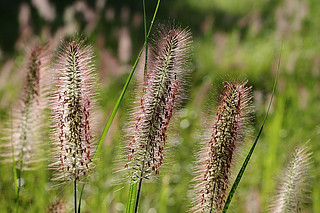
Foxtails are generally the invasive type of weeds that can spread in pastures, yards, and other grassy areas. The best way of taming the foxtail menace is to attack it as fast as possible. This involves using a chemical or organic method or both to get rid of foxtail.
Chemical Herbicides
1. Use Glyphosate or Other Similar Products
Foxtail is grass, so broadleaf fertilizer will not be effective against it. If you prefer the chemical control method, then opt for herbicides like glyphosate. Glyphosate is a non-selective and potent herbicide; it kills just anything you apply it on.
In essence, when you apply glyphosate in an area, it would kill both the grass and, most likely, your vegetable. Regardless, this is the most effective method of eliminating foxtail for good.
2. Apply Several Times
Foxtail is somewhat stubborn, and so you may need to spray it with herbicide for two to three days before it dies completely. Wait for the re-growth of the new foxtail before spraying another round of the herbicide.
It usually takes between two to three weeks before another foxtail re-emerges, especially if a potent herbicide like glyphosate is used.
3. Combine Both the Organic Weed-Control With the Chemical Method.
Chemical herbicides are potent against foxtail, which of course, handles the majority of the problem. But combining some organic control methods with the use of herbicides can potentially hasten up the extermination process.
One of these organic methods is to turn under the dead residue of the foxtail. This should be done after seven to ten days of applying the herbicide.
Organic Solution
1. Dig or Pull Out the Weeds
This organic method doesn’t require any form of chemicals. Simply dig out the weeds and dispose of them from the affected area.
Make sure you remove the weeds together with their roots. Here are some tips on how to do it the right way:
- Firstly, remove the seed heads to halt them from infiltrating the area with further foxtail.
- Next is to dig deep to the root of the weed with a slender weeding tool. Weeds are usually easier to pull out when they are still young or on wet soil.
- You can pull the foxtail from the soil with gardening gloves on. You could also use tools like a weed-wackier.
2. Apply Vinegar
If you want to preserve your vegetables while trying to get rid of foxtail, you can apply vinegar instead. Vinegar is a natural substance with a bit of acid but is very potent in eliminating weeds like a foxtail.
- The USDA-approved vinegar has about five percent of acetic acid.
- Apply the vinegar directly at the base of the foxtail. Ensure it gets to the roots.
- Soak the soil under the weed with enough vinegar. It doesn’t necessarily have to be wet; just make it damp to the touch.
- Pull out dying or dead foxtail immediately. This normally takes between one to two weeks after applying the vinegar. Re-soak foxtails that are still growing after two weeks with more vinegar.
- Note that vinegar is more potent on foxtail during the seedling stage. It is less effective for the matured foxtail.
3. Use Urine
Pouring urine onto your vegetation or lawn may sound weird, but it is as effective as vinegar. Urine has a solid organic alkaline substance; it is potent against foxtail like other herbicides.
- You can buy “predator urine” products and apply them to your lawn or yard. They are usually used to repel small garden pests. You can also use such urine for herbicidal purposes.
- Like other control methods, multiple applications of urine may be needed for effective results. You can also use it in conjunction with herbicide or with a physical removal method. Remove dying or dead foxtail with a garden hoe or your hand.
- Note that human urine is cheaper and more effective at killing foxtail. Collect the urine and pour it at the base of the foxtail, aiming at the roots.
4. Use Mulch on the Affected Area
You can quickly kill a fairly young foxtail by covering it with some mulch. The idea behind this method is to deliberately deprive the foxtail of nutrients and light, which are necessary for growth. Since they are still tender, they can easily die off.
- You will need to trim the foxtail so low before covering it with mulch.
- Organic mulches like shredded leaves, wood chips, and wheat straw work well
Future Prevention
1. Use Pre-emergence Herbicide
This method is recommended to persons that prefer only chemical treatment. Pre-emergence herbicides should be used after any form of chemical treatment, just any new growth.
You can use any of these standard chemical options like pendimethalin, Balan, and dacthal. But if you prefer organic pre-emergent herbicide, use corn gluten meal.
Spray the herbicide immediately after a new lawn starts growing to prevent foxtail from establishing its roots. It is not advisable to use pre-emergent herbicides before developing a new lawn. This is because it could also stop the growth of your desired grass.
Furthermore, it is best to use pre-emergent herbicides in the spring. It shouldn’t be applied too early so as to preserve its potency.
2. Grow Other Plants in the Area
When a piece of land is by too many plants, it will lead to stiff competition for available nutrients and resources. Some plants will inevitably die due to a lack of nutrients.
When choosing what to plant, go for solid-stand crops like grass, hay, or legumes. Don’t plant row crops like corn or soybeans; they are not effective at mitigating foxtail growth. If you chose to plant any type of grass, then keep it healthy, thick, and plush. Tick grass can help to mitigate the growth of foxtail.
3. Check the pH of the Soil
Plants thrive well in different soil conditions. Look for plants that will do well in your yard. They will absorb more nutrients from the soil. Foxtail will therefore have little or no nutrients to survive.
The pH of your soil will determine the type of vegetation you have. You can take a sample of your soil to the lab for the pH to be analyzed. Note that using herbicides can alter the pH of your soil.
Conclusion
Foxtails can easily overrun your yard or lawn if you don’t act fast. We’ve discussed both the chemical and organic methods of fighting foxtails and also how to keep them in check. You can use any of the methods that suit you. Thank you for your time reading this article. If you have some questions, please leave your comment below, and I’ll be happy to write back to you.

Paolo
To get rid of foxtail weed, my favorite method is to dilute 4-5 tablespoons of glyphosate in 1 gallon of water. But if we are not careful, this solution may enter into contact with other plants on our lawn. And we don’t want that. So to solve this, I like to apply glyphosate on foxtail with a sponge applicator.
admin
Hi Paolo,
Thanks once again for your time to visit my site. Good to know that you are already using glyphosate on foxtail. Thank you so much for your kind comment. All the best,
Joyce
Kokontala
Hi there! I went through your article on how to get rid of Foxtails. A great article. This is just what I’ve been looking for. My garden is full of foxtails, and I tried several chemicals to remove them but to no avail. I think it’s time I try the glyphosate even though I have so many lovely flowers in my garden too. I’d rather start planting new ones as the chemical will kill all my plants. I wouldn’t say I like the way my garden is covered with foxtails.
Please tell me, where can I buy this chemical, glyphosate?
Thank you for sharing.
Then lo.
admin
Hello Kokontala,
Thank you so much for your comment and for stopping.
Best wishes and Thanks,
Joyce
Sammy Allen
I used to live in Oregon, and there were so many foxtails everywhere. They look like little aliens.
I would never have thought urine was a method. That’s fascinating. Alright, I can think of some people who might get pretty excited about that.
Great article – very detailed. You know nature, girl.
L,
Sammy
admin
Thank you so much for visiting my site and for commenting.
Best wishes,
Joyce
Eileen Lawrence
I recently purchased a summer home in California. The backyard (~3,000 square feet) is covered with foxtails. This weed is new to me, as we don’t have foxtails in Maryland. Your article is extremely helpful–thank you. I’ll start work now getting rid of the live plants. Before knowing better, I mowed the yard. QUESTION: Now the dried, chopped-off seed heads are lying all over the place. Do you have a way to get rid of them? They can’t be raked up or blown away, and they’re posing a danger to my dog. Is there something I can apply that will cause them to break down? Sorry… I don’t use Facebook. Thanks for any suggestions. This is a nightmare–we can’t use our new yard.